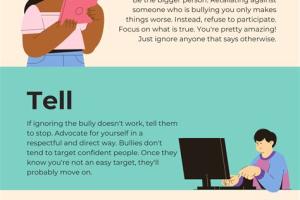Effective Strategies to Stop Cyber Bullying: A Complete Guide

-
Quick Links:
- Understanding Cyber Bullying
- Types of Cyber Bullying
- Impact of Cyber Bullying
- Prevention Strategies
- How to Recover from Cyber Bullying
- Case Studies
- Expert Insights
- FAQs
Understanding Cyber Bullying
Cyber bullying involves the use of digital technologies to harass, threaten, or intimidate individuals. This form of bullying can occur on social media, messaging apps, online forums, and other digital platforms. Understanding the definition and dynamics of cyber bullying is crucial for effective prevention and intervention.
Types of Cyber Bullying
Cyber bullying can manifest in various ways, including:
- Harassment: Repeatedly sending offensive messages.
- Impersonation: Pretending to be someone else to damage their reputation.
- Outing: Sharing personal information without consent.
- Exclusion: Intentionally excluding someone from online groups.
- Flaming: Posting inflammatory comments to provoke others.
Impact of Cyber Bullying
The effects of cyber bullying can be profound and far-reaching, impacting mental health, academic performance, and even physical well-being. Studies have shown that victims often experience:
- Increased anxiety and depression
- Lower self-esteem
- Academic challenges
- Social withdrawal
According to the StopBullying.gov, victims of cyber bullying are much more likely to consider self-harm or suicide.
Prevention Strategies
Preventing cyber bullying involves a multi-faceted approach that includes education, policy implementation, and community engagement. Here are some effective strategies to stop cyber bullying:
1. Educate Yourself and Others
Understanding the signs and consequences of cyber bullying is the first step in prevention. Schools and parents should provide educational resources on digital etiquette and respectful online communication.
2. Promote Digital Citizenship
Teaching responsible online behavior can empower individuals to stand up against cyber bullying. This includes understanding the impact of their words and actions in digital spaces.
3. Create Safe Online Spaces
Encouraging the development of supportive online communities can help mitigate instances of cyber bullying. This may involve setting clear guidelines and offering support systems for victims.
4. Implement Strong Policies
Schools and organizations should have clear policies addressing cyber bullying, including procedures for reporting and responding to incidents. Effective policies can deter potential bullies and empower victims.
5. Encourage Open Communication
Encouraging open dialogue between victims and trusted adults can help victims feel supported and less isolated. This communication should be non-judgmental and empathetic.
How to Recover from Cyber Bullying
Recovering from the trauma of cyber bullying can be a long process. Here are steps to help victims:
- Seek Support: Reach out to friends, family, or mental health professionals.
- Document Evidence: Keep records of abusive messages or posts as evidence.
- Report the Abuse: Use the reporting features of social media platforms and notify authorities if necessary.
- Focus on Self-Care: Engage in activities that promote mental well-being, such as exercise and hobbies.
Case Studies
To illustrate the effects and resolutions of cyber bullying, we can examine a few case studies:
Case Study 1: Amanda Todd
Amanda Todd, a Canadian teenager, faced severe cyber bullying after being blackmailed by an online predator. Her story highlights the extreme consequences of cyber bullying and the importance of intervention.
Case Study 2: Tyler Clementi
Tyler Clementi, a college student, took his own life after being bullied online. His story led to increased awareness and advocacy for anti-bullying legislation.
Expert Insights
Experts agree that a comprehensive approach is necessary to combat cyber bullying effectively. Dr. Sameer Hinduja, co-director of the Cyberbullying Research Center, emphasizes the importance of intervention strategies and peer support in reducing incidents of cyber bullying.
FAQs
1. What is cyber bullying?
Cyber bullying is the use of digital platforms to harass or intimidate individuals.
2. How can I recognize if someone is being bullied online?
Signs include sudden changes in behavior, withdrawal from social activities, and reluctance to use digital devices.
3. What should I do if I am a victim of cyber bullying?
Document the incidents, report them, and seek support from trusted individuals.
4. Can parents help prevent cyber bullying?
Yes, by educating their children about online safety and encouraging open communication.
5. What legal actions can be taken against cyber bullies?
Victims can report incidents to law enforcement, and there may be legal consequences for the bully.
6. Are there any resources for cyber bullying victims?
Yes, organizations like Bullying.org and StopBullying.gov provide resources and support.
7. How can schools address cyber bullying?
Schools can implement anti-bullying policies, provide training for staff, and create supportive environments.
8. Is cyber bullying worse than traditional bullying?
Many argue that cyber bullying can be more damaging due to its pervasive nature and anonymity.
9. What role do social media platforms play in cyber bullying?
Social media platforms can either enable or combat cyber bullying through their policies and reporting mechanisms.
10. How can friends support someone being bullied online?
Friends can offer emotional support, encourage reporting incidents, and stand up against the bully.
Random Reads
- How to switch to japanese app store
- How to switch sim cards
- How to keep birds off your porch
- How to install doorstop
- Mastering fishing wires conduits
- Mastering five nights at freddys 3
- How to restore a musty mattress
- How to play minecraft
- How to play minecraft multiplayer
- How to remove ceramic or porcelain tile